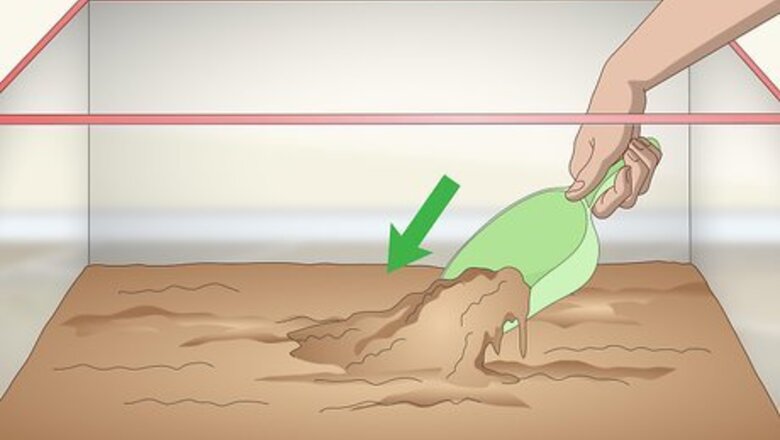
views
Preparing the Tank’s Interior
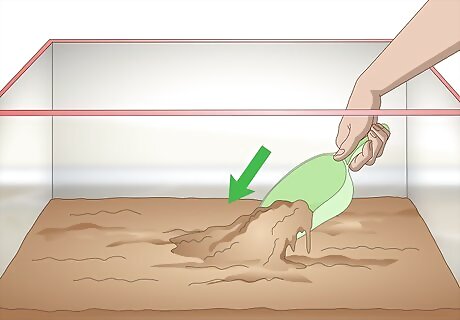
Line the bottom of the tank with a natural substrate. Substrate is the material on the bottom of the tank that the lizards will walk through. It’s best if the substrate mimics natural materials that the lizards would experience in nature. So, try lining the tank bottom with a dampened layer of peat moss. Or, lay 2 inches (5.1 cm) of potting soil on the bottom of the tank and cover it with bark mulch. You should be able to purchase all of these materials at a pet store or a home-improvement store. If you’re keeping baby anoles, you can use 6-7 paper towels as a substrate if you feed the babies inside the cage. However, purchasing baby anoles isn’t recommended unless you’re an experienced lizard owner.
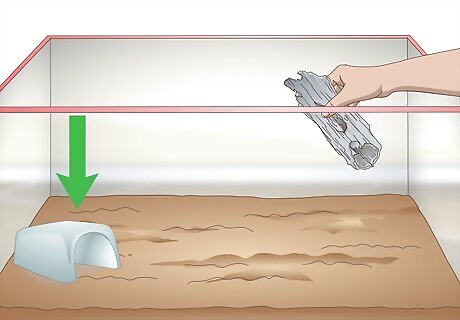
Set 2 hides on opposite sides of the tank. Hides are 8–10 in (20–25 cm) natural-looking cave-like structures commonly used in terrariums and lizard tanks. As the name suggests, they give the anoles a place to hide or to rest. Purchase 2 hides from a pet store and set them at opposite ends of the tank: 1 in the warm area under the light, for basking, and one on the cool side with no light. Different anoles prefer different types of hides. If you notice your lizard isn’t using the hides you purchased, try buying a hide of a different size, material, or color.
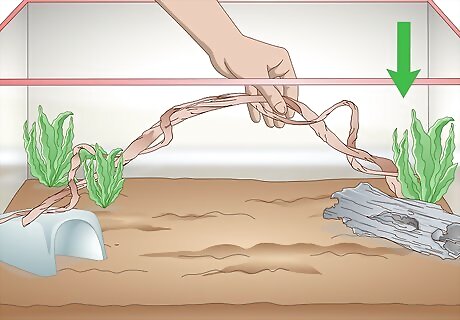
Decorate the cage with plastic plants and acrylic vines. These items are more than cosmetic; they’ll give the anoles a place to climb. Anoles don’t spend much time on the ground in their natural habitat, and so these climbing obstacles are a necessity. Local pet stores will sell climbable items that stick to the inner tank walls with plastic suction cups. Purchase at least 3 plants or vines per anole. Depending on the size of the tank, you could also place small live plants in the substrate at the bottom of the tank. Anoles prefer plants with broad, sturdy leaves, like ficus, pothos, dracaena, or philodendrons. Avoid using any live plants that may poison your anoles, including bird of paradise, heliotrope, and ivy.
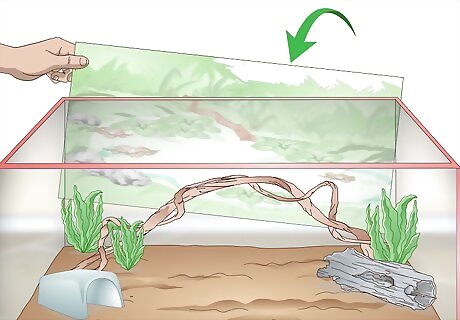
Install a tropical background in the tank for a purely cosmetic touch. If you think the tank looks a little plain, purchase a background with a brightly colored tropical background at your local pet store. Install this on one of the tank’s long sides, and position the tank at an angle that allows you to see the colorful background. This type of background does nothing for the anoles and is purely for the aesthetic benefit of their owners.
Selecting and Situating a Tank

Place the tank at least 5 feet (1.5 m) off the ground in your home. Anoles are used to being somewhat elevated in their natural climates, so try to replicate this in captivity. Set your anoles on a surface that’s more or less at your eye level. For example, place the tank on the top of a low bookcase or a high piece of furniture. If you set the tank on a low table or on the ground, the anoles will feel uncomfortable, especially if there are children or pets wandering near the cage.
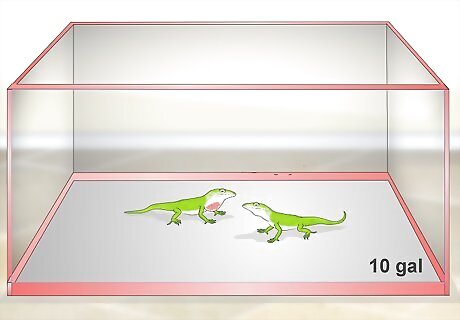
Purchase a 10 US gal (38 L) glass tank for a 1-2 adult anoles. Although anole lizards are small, they need plenty of space to move around, eat, rest, and use the bathroom. Visit a local pet store and purchase a glass tank that’s at least 10 gallons (38 L) in size. This will work if you’re planning to keep 1-2 anoles, which is a good number for a beginner lizard owner. It’s okay to keep 2 or 3 female anoles in a single tank, since they won’t fight. However, male anoles should be given their own tank.
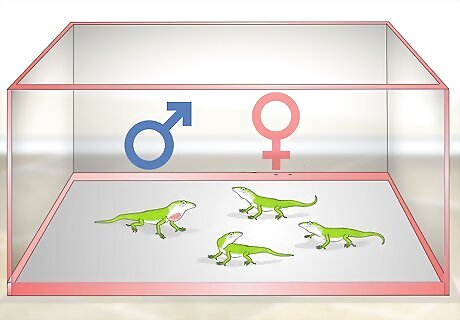
Keep 1 male and 3 or 4 females in a 20 US gal (76 L) tank. If you’d like to keep more than 1-2 lizards in a tank, the tank size should be twice as large. Purchase a glass tank of this size at your local pet store. A 20 US gal (76 L) tank will give the anoles enough room to bask in warm areas and hide when they need time alone. It’s not recommended that you keep more than 4-5 unless you’re an experienced anole breeder. Keep an eye on the male anole in this situation and make sure that it doesn’t start acting aggressively towards the females.
Providing Water, Food, and Heat
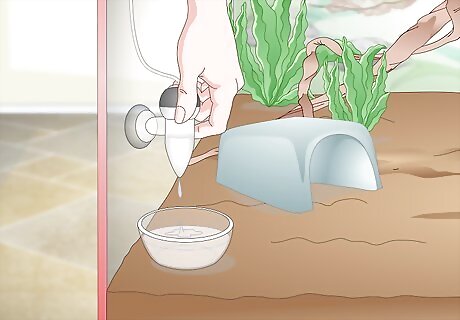
Set up a water dripper over a shallow 3 in (7.6 cm) bowl. In their natural environment, anoles drink water out of streams and off of rain-covered leaves. Simulate this in captivity by attaching a water dripper to 1 side of the anole’s tank. Under the dripper’s spout, situate a small plastic or metal bowl that’s not more than 2 inches (5.1 cm) high. The anole will learn to drink either from the dripper or out of the bowl. Do not fill the dripper with tap water, which may contain impurities. Instead, fill it with distilled bottled water purchased from a supermarket.
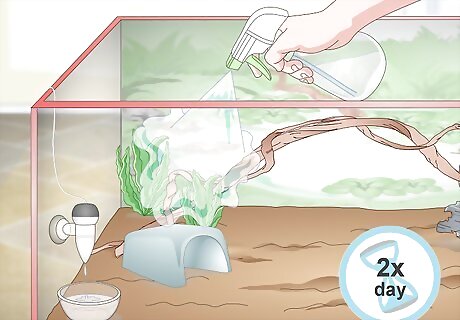
Spray the greenery in the tank 2 times every day. Anoles may not drink from the water bowl and, even if they do, they still need a humid, wet environment to survive. Fill a small spray bottle with distilled bottled water and, twice daily, spray a generous amount of water across the leaves and other greenery in the cage. Don’t spray water directly onto the anole.
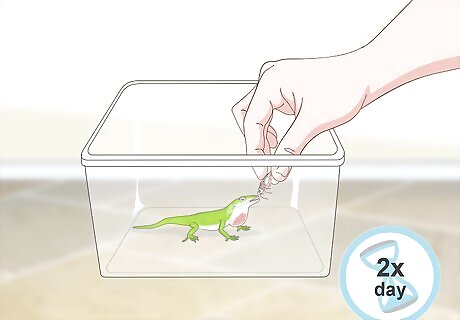
Feed the anoles live crickets 2 times per day. Anoles need to eat frequently, and their diet in captivity should mimic their natural diet as closely as possible. Purchase live crickets from a pet store, and feed them to your anoles once in the morning and once in the evening. Until you figure out exactly how much your anoles will eat, feed each anole 3 crickets. Different anoles prefer different types of food. If 1 of your anoles doesn’t seem to like crickets, try adding a few mealworms at mealtime and see if the anoles eat them.
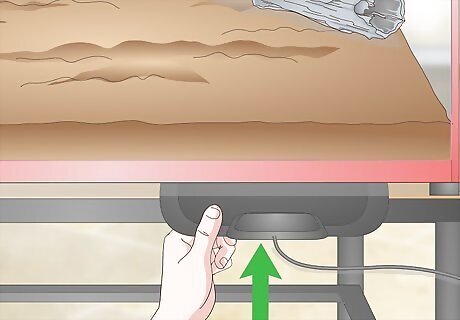
Attach a reptile heat pad beneath the glass tank at 1 end. Anoles are cold blooded and their tank needs to have a temperature gradient so they can adjust their temperature as needed. Purchase a reptile heat pad at a pet store and stick the pad beneath the glass of the anole tank. These pads need to plug into the wall and can be left on for 24 hours a day. Never set reptile heat rocks in an anole tank. These rocks are potentially hazardous and may burn anoles.
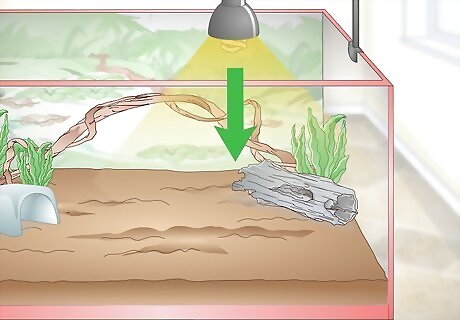
Set a heat lamp over the tank on the same side as the heat pad. Set a heat lamp with a basking dome directly over the tank, pointing downward so it will warm the anole. Place the heat lamp on the same side as the reptile heat pad. This will ensure that this side of the tank is always hot, while the other side remains cool. Different heat lamps have different means of attaching to the tank. Some have a suction cup that can attach to the side of the glass, while others have small clips that can hook onto the top of the tank.
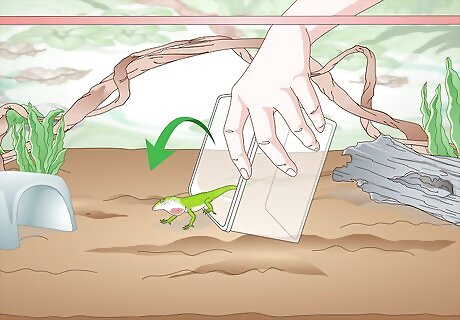
Put your anoles in the tank and watch them explore their new home. In general, anoles dislike being handled. So, don’t grab your anole with your hands and shove it into its tank. Instead, take the small crate or tank in which the anole came home from the pet store and set it in the bottom of the tank. Open the small carrying case, let the anole crawl out, and then remove the carrying case and close the large tank. Once your anoles have gotten used to their tanks, you can handle them lightly.



















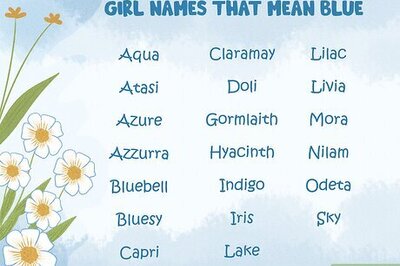
Comments
0 comment